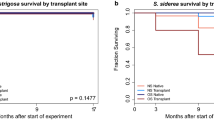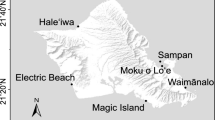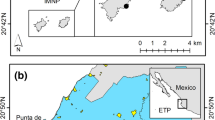Abstract
Worldwide decline in coral populations has led to the development of numerous coral conservation and restoration groups. These groups have established successful methods for propagating and growing corals in nurseries for outplanting to degraded reefs. However, the environment within land-based nurseries differs from natural reef environments since nursery conditions are optimized to aid coral health and accelerate growth. This study compares the physiological condition of Mote Marine Laboratory’s land-based nursery corals to over two decades of coral physiology data collected seasonally from wild conspecific populations of the Florida Keys. Coral metabolism metrics suggest that nursery corals are similar to wild conspecifics. Despite this, coral biomass and symbiotic algae pigmentation suggest that Mote’s land-based nursery corals are acclimated to low light, and maintain different Symbiodiniaceae populations compared to wild conspecifics. Our findings elucidate how the biology and physiology of corals raised in land-based nurseries are different from wild coral populations and indicate nursery corals likely incur substantial photoacclimation processes during outplanting. These insights provide a physiological framework for coral conservation and management efforts that can be used when considering the condition of nursery-raised corals before outplanting to a reef.






Similar content being viewed by others
Data availability
The DNA sequences generated and analyzed during the current study are available in GenBank, https:// www. ncbi. nlm. nih. gov/ nucco re/? term= ON455 821: ON455 829[accn]. All other datasets generated and/or analyzed during this study are available from the corresponding author on reasonable request.
References
Anthony KR, Hoegh-Guldberg O (2003) Kinetics of photoacclimation in corals. Oecologia 134:23–31
Banister RB, van Woesik R (2021) Ranking 67 Florida reefs for survival of Acropora cervicornis outplants. Frontiers in Marine Science 8:672574
Baums IB, Devlin-Durante MK, LaJeunesse TC (2014) New insights into the dynamics between reef corals and their associated dinoflagellate endosymbionts from population genetic studies. Molecular Ecology 23:4203–4215
Baums IB, Johnson ME, Devlin-Durante MK, Miller MW (2010) Host population genetic structure and zooxanthellae diversity of two reef-building coral species along the Florida Reef Tract and wider Caribbean. Coral Reefs 29:835–842
Bayraktarov E, Stewart-Sinclair PJ, Brisbane S, Boström-Einarsson L, Saunders MI, Lovelock CE, Possingham HP, Mumby PJ, Wilson KA (2019) Motivations, success, and cost of coral reef restoration. Restoration Ecology 27:981–991
Borell EM, Yuliantri AR, Bischof K, Richter C (2008) The effect of heterotrophy on photosynthesis and tissue composition of two scleractinian corals under elevated temperature. Journal of Experimental Marine Biology and Ecology 364:116–123
Boström-Einarsson L, Babcock RC, Bayraktarov E, Ceccarelli D, Cook N, Ferse SCA, Hancock B, Harrison P, Hein M, Shaver E, Smith A, Suggett D, Stewart-Sinclair PJ, Vardi T, McLeod IM (2020) Coral restoration—A systematic review of current methods, successes, failures and future directions. PLOS ONE 15:e0226631
Chalker BE, Taylor DL, Smith DC (1978) Rhythmic variations in calcification and photosynthesis associated with the coral Acropora cervicornis (Lamarck). Proceedings of the Royal Society of London Series B Biological Sciences 201:179–189
Chapron L, Schoepf V, Levas SJ, Aschaffenburg MD, Warner ME, Grottoli AG (2022) Natural variability in Caribbean coral physiology and implications for coral bleaching resilience. Frontiers in Marine Science 8:811055
Cohen I, Dubinsky Z (2015) Long term photoacclimation responses of the coral Stylophora pistillata to reciprocal deep to shallow transplantation: photosynthesis and calcification. Frontiers in Marine Science 2:45
Colombo-Pallotta MF, Rodríguez-Román A, Iglesias-Prieto R (2010) Calcification in bleached and unbleached Montastraea faveolata: evaluating the role of oxygen and glycerol. Coral Reefs 29:899–907
Conlan JA, Bay LK, Severati A, Humphrey C, Francis DS (2018) Comparing the capacity of five different dietary treatments to optimise growth and nutritional composition in two scleractinian corals. PLOS ONE 13:e0207956
Conlan JA, Humphrey CA, Severati A, Parrish CC, Francis DS (2019) Elucidating an optimal diet for captive Acropora corals. Aquaculture 513:734420
Craggs J, Guest J, Davis M, Sweet M (2020) Completing the life cycle of a broadcast spawning coral in a closed mesocosm. Invertebrate Reproduction & Development 64:244–247
Cunning R, Baker AC (2020) Thermotolerant coral symbionts modulate heat stress-responsive genes in their hosts. Molecular Ecology 29:2940–2950
Cunning R, Parker KE, Johnson-Sapp K, Karp RF, Wen AD, Williamson OM, Bartels E, D’Alessandro M, Gilliam DS, Hanson G (2021) Census of heat tolerance among Florida’s threatened staghorn corals finds resilient individuals throughout existing nursery populations. Proceedings of the Royal Society B 288:20211613
Dubinsky Z, Falkowski PG, Porter JW, Muscatine L, Smith DC (1984) Absorption and utilization of radiant energy by light- and shade-adapted colonies of the hermatypic coral Stylophora pistillata. Proceedings of the Royal Society of London Series B Biological Sciences 222:203–214
Fagoonee I, Wilson HB, Hassell MP, Turner JR (1999) The dynamics of zooxanthellae populations: A long-term study in the field. Science 283:843–845
Fisher T, Berner T, Iluz D, Dubinsky Z (1998) The kinetics of the photoacclimation response of Nannochloropsis sp. (Eustigmatophyceae): A study of changes in ultrastructure and PSU density. Journal of Phycology 34:818–824
Fitt WK (2000) Cellular growth of host and symbiont in a cnidarian-zooxanthellar symbiosis. The Biological Bulletin 198:110–120
Fitt WK, Warner ME (1995) Bleaching patterns of four species of Caribbean reef corals. The Biological Bulletin 189:298–307
Fitt WK, McFarland F, Warner ME, Chilcoat GC (2000) Seasonal patterns of tissue biomass and densities of symbiotic dinoflagellates in reef corals and relation to coral bleaching. Limnology and Oceanography 45:677–685
Fitt WK, Brown BE, Warner ME, Dunne RP (2001) Coral bleaching: interpretation of thermal tolerance limits and thermal thresholds in tropical corals. Coral Reefs 20:51–65
Forsman ZH, Page CA, Toonen RJ, Vaughan D (2015) Growing coral larger and faster: micro-colony-fusion as a strategy for accelerating coral cover. PeerJ 3:e1313
Fox J, Friendly GG, Graves S, Heiberger R, Monette G, Nilsson H, Ripley B, Weisberg S, Fox MJ, Suggests M (2007) The car package. R Foundation for Statistical Computing 1109
Goergen EA, Gilliam DS (2018) Outplanting technique, host genotype, and site affect the initial success of outplanted Acropora cervicornis. PeerJ 6:e4433
Grottoli AG, Rodrigues LJ, Palardy JE (2006) Heterotrophic plasticity and resilience in bleached corals. Nature 440:1186–1189
Grottoli AG, Warner ME, Levas SJ, Aschaffenburg MD, Schoepf V, McGinley M, Baumann J, Matsui Y (2014) The cumulative impact of annual coral bleaching can turn some coral species winners into losers. Global Change Biology 20:3823–3833
Hagedorn M, Page Christopher A, O’Neil Keri L, Flores Daisy M, Tichy L, Conn T, Chamberland Valérie F, Lager C, Zuchowicz N, Lohr K, Blackburn H, Vardi T, Moore J, Moore T, Baums Iliana B, Vermeij Mark JA, Marhaver Kristen L (2021) Assisted gene flow using cryopreserved sperm in critically endangered coral. Proceedings of the National Academy of Sciences 118:e2110559118
Hennige SJ, Smith DJ, Perkins R, Consalvey M, Paterson DM, Suggett DJ (2008) Photoacclimation, growth and distribution of massive coral species in clear and turbid waters. Marine Ecology Progress Series 369:77–88
Hoegh-Guldberg O, Mumby P, Hooten A, Steneck R, Greenfield P, Gomez E, Harvell C, Sale P, Edwards A, Caldeira K (2007) Coral reefs under rapid climate change and ocean acidification. Science 318:1737–1742
Hoogenboom MO, Connolly SR, Anthony KRN (2009) Effects of photoacclimation on the light niche of corals: a process-based approach. Marine Biology 156:2493–2503
Houlbrèque F, Ferrier‐Pagès C (2009) Heterotrophy in tropical scleractinian corals. Biological Reviews 84:1–17
Hughes TP, Kerry JT, Baird AH, Connolly SR, Dietzel A, Eakin CM, Heron SF, Hoey AS, Hoogenboom MO, Liu G, McWilliam MJ, Pears RJ, Pratchett MS, Skirving WJ, Stella JS, Torda G (2018) Global warming transforms coral reef assemblages. Nature 556:492–496
Jeffrey SW, Humphrey GF (1975) New spectrophotometric equations for determining chlorophylls a, b, c1 and c2 in higher plants, algae and natural phytoplankton. Biochemie und Physiologie der Pflanzen 167:191–194
Johannes RE, Wiebe WJ (1970) Method for determination of coral tissue biomass and composition 1. Limnology and Oceanography 15:822–824
Jones RJ, Yellowlees D (1997) Regulation and control of intracellular algae (= zooxanthellae) in hard corals. Philosophical Transactions of the Royal Society of London Series B: Biological Sciences 352:457–468
Kemp DW, Hernandez-Pech X, Iglesias-Prieto R, Fitt WK, Schmidt GW (2014) Community dynamics and physiology of Symbiodinium spp. before, during, and after a coral bleaching event. Limnology and Oceanography 59:788–797
Kemp DW, Oakley CA, Thornhill DJ, Newcomb LA, Schmidt GW, Fitt WK (2011) Catastrophic mortality on inshore coral reefs of the Florida Keys due to severe low‐temperature stress. Global Change Biology 17:3468–3477
Kemp DW, Thornhill DJ, Rotjan RD, Iglesias-Prieto R, Fitt WK, Schmidt GW (2015) Spatially distinct and regionally endemic Symbiodinium assemblages in the threatened Caribbean reef-building coral Orbicella faveolata. Coral Reefs 34:535–547
Kemp DW, Colella MA, Bartlett LA, Ruzicka RR, Porter JW, Fitt WK (2016) Life after cold death: reef coral and coral reef responses to the 2010 cold water anomaly in the Florida Keys. Ecosphere 7:e01373
Knutson DW, Buddemeier RW, Smith SV (1972) Coral Chronometers: Seasonal growth bands in reef corals. Science 177:270–272
LaJeunesse T (2002) Diversity and community structure of symbiotic dinoflagellates from Caribbean coral reefs. Marine Biology 141:387–400
LaJeunesse TC, Smith RT, Finney J, Oxenford H (2009) Outbreak and persistence of opportunistic symbiotic dinoflagellates during the 2005 Caribbean mass coral ‘bleaching’ event. Proceedings of the Royal Society B: Biological Sciences 276:4139–4148
Leinbach SE, Speare KE, Rossin AM, Holstein DM, Strader ME (2021) Energetic and reproductive costs of coral recovery in divergent bleaching responses. Scientific Reports 11:23546
Lesser MP, Slattery M, Stat M, Ojimi M, Gates RD, Grottoli A (2010) Photoacclimatization by the coral Montastraea cavernosa in the mesophotic zone: light, food, and genetics. Ecology 91:990–1003
Lirman D, Schopmeyer S, Galvan V, Drury C, Baker AC, Baums IB (2014) Growth dynamics of the threatened Caribbean Staghorn coral Acropora cervicornis: Influence of host genotype, symbiont identity, colony size, and environmental setting. PLOS ONE 9:e107253
Loya Y, Sakai K, Yamazato K, Nakano Y, Sambali H, Van Woesik R (2001) Coral bleaching: The winners and the losers. Ecology Letters 4:122–131
Manzello DP, Matz MV, Enochs IC, Valentino L, Carlton RD, Kolodziej G, Serrano X, Towle EK, Jankulak M (2019) Role of host genetics and heat-tolerant algal symbionts in sustaining populations of the endangered coral Orbicella faveolata in the Florida Keys with ocean warming. Global Change Biology 25:1016–1031
Marsh JA (1970) Primary productivity of reef-building calcareous red algae. Ecology 51:255–263
Mass T, Einbinder S, Brokovich E, Shashar N, Vago R, Erez J, Dubinsky Z (2007) Photoacclimation of Stylophora pistillata to light extremes: metabolism and calcification. Marine Ecology Progress Series 334:93–102
McGinley MP (2012) The impact of environmental stress on Symbiodinium spp.: a molecular and community-scale investigation. Dissertation Ph.D. thesis, University of Delaware, p165
Merck DE, Petrik CG, Manfroy AA, Muller EM (2022) Optimizing seawater temperature conditions to increase the productivity of ex situ coral nurseries. PeerJ 10:e13017
Mieog JC, Van Oppen MJH, Berkelmans R, Stam WT, Olsen JL (2009) Quantification of algal endosymbionts (Symbiodinium) in coral tissue using real-time PCR. Molecular Ecology Resources 9:74–82
Oksanen J, Blanchet FG, Kindt R, Legendre P, Minchin PR, O’hara R, Simpson GL, Solymos P, Stevens MHH, Wagner H (2013) Package ‘vegan’. Community ecology package, version 2:1–295
Owen DP, Long MH, Fitt WK, Hopkinson BM (2021) Taxon-specific primary production rates on coral reefs in the Florida Keys. Limnology and Oceanography 66:625–638
Page CA, Muller EM, Vaughan DE (2018) Microfragmenting for the successful restoration of slow growing massive corals. Ecological Engineering 123:86–94
Parker KE, Ward JO, Eggleston EM, Fedorov E, Parkinson JE, Dahlgren CP, Cunning R (2020) Characterization of a thermally tolerant Orbicella faveolata reef in Abaco, The Bahamas. Coral Reefs 39:675–685
Pausch RE, Williams DE, Miller MW (2018) Impacts of fragment genotype, habitat, and size on outplanted elkhorn coral success under thermal stress. Marine Ecology Progress Series 592:109–117
Pettay DT, Wham DC, Smith RT, Iglesias-Prieto R, LaJeunesse TC (2015) Microbial invasion of the Caribbean by an Indo-Pacific coral zooxanthella. Proceedings of the National Academy of Sciences 112:7513–7518
Rinkevich B (2005) Conservation of coral reefs through active restoration measures: Recent approaches and last decade progress. Environmental Science & Technology 39:4333–4342
Schlecker L, Page C, Matz M, Wright RM (2022) Mechanisms and potential immune tradeoffs of accelerated coral growth induced by microfragmentation. PeerJ 10:e13158
Seutin G, White BN, Boag PT (1991) Preservation of avian blood and tissue samples for DNA analyses. Canadian Journal of Zoology 69:82–90
Shaver EC, McLeod E, Hein MY, Palumbi S, Quigley K, Vardi T, Mumby PJ, Smith D, Montoya-Maya P, Muller E, Banaszak AT, McLeod IM, Wachenfeld D (2022) A roadmap to integrating resilience into the practice of coral reef restoration. Global Change Biology
Szmant AM, Gassman NJ (1990) The effects of prolonged “bleaching” on the tissue biomass and reproduction of the reef coral Montastrea annularis. Coral Reefs 8:217–224
Takahashi S, Whitney S, Itoh S, Maruyama T, Badger M (2008) Heat stress causes inhibition of the de novo synthesis of antenna proteins and photobleaching in cultured Symbiodinium. Proceedings of the National Academy of Sciences 105:4203–4208
Tansik AL, Fitt WK, Hopkinson BM (2017) Inorganic carbon is scarce for symbionts in scleractinian corals. Limnology and Oceanography 62:2045–2055
Thornhill DJ, LaJeunesse TC, Kemp DW, Fitt WK, Schmidt GW (2006) Multi-year, seasonal genotypic surveys of coral-algal symbioses reveal prevalent stability or post-bleaching reversion. Marine Biology 148:711–722
Thornhill DJ, Rotjan RD, Todd BD, Chilcoat GC, Iglesias-Prieto R, Kemp DW, LaJeunesse TC, Reynolds JM, Schmidt GW, Shannon T (2011) A connection between colony biomass and death in Caribbean reef-building corals. PLoS One 6:e29535
van Woesik R, Scott WJ, Aronson RB (2014) Lost opportunities: Coral recruitment does not translate to reef recovery in the Florida Keys. Marine Pollution Bulletin 88:110–117
Ware M, Garfield EN, Nedimyer K, Levy J, Kaufman L, Precht W, Winters RS, Miller SL (2020) Survivorship and growth in staghorn coral (Acropora cervicornis) outplanting projects in the Florida Keys National Marine Sanctuary. PLOS ONE 15:e0231817
Warner M, Chilcoat G, McFarland F, Fitt W (2002) Seasonal fluctuations in the photosynthetic capacity of photosystem II in symbiotic dinoflagellates in the Caribbean reef-building coral Montastraea. Marine Biology 141:31–38
Warner ME, Fitt WK, Schmidt GW (1999) Damage to photosystem II in symbiotic dinoflagellates: A determinant of coral bleaching. Proceedings of the National Academy of Sciences 96:8007–8012
Warner ME, Lesser MP, Ralph PJ (2010) Chlorophyll Fluorescence in Reef Building Corals. In: Suggett DJ, Prášil O, Borowitzka MA (eds) Chlorophyll a Fluorescence in Aquatic Sciences: Methods and Applications. Springer Netherlands, Dordrecht, pp 209–222
Yakovleva I, Hidaka M (2004) Differential recovery of PSII function and electron transport rate in symbiotic dinoflagellates as a possible determinant of bleaching susceptibility of corals. Marine Ecology Progress Series 268:43–53
Acknowledgements
We thank all the interns and staff at Mote’s IC2R3 facility for aid with sample and data collection. We also thank Derek Manzello and NOAA’s Atlantic Oceanography and Meteorological Laboratory for help with environmental data. Funding was provided by Mote Protect our Reef program to DK and EM (POR-2020-04), National Science Foundation Grant NSF-0137007 awarded to WF, and University of Alabama at Birmingham start-up funds for DK. All wild sample collections were authorized under Florida Keys National Marine Sanctuary permit # FKNMS-2019-185, 2017-117, 2011-093, 2007-121-A2. Corals within Mote’s land-based nursery were authorized under FKNMS-2019-149.
Author information
Authors and Affiliations
Corresponding authors
Ethics declarations
Conflict of interest
Authors declare no competing interests.
Additional information
Publisher's Note
Springer Nature remains neutral with regard to jurisdictional claims in published maps and institutional affiliations.
Rights and permissions
Springer Nature or its licensor (e.g. a society or other partner) holds exclusive rights to this article under a publishing agreement with the author(s) or other rightsholder(s); author self-archiving of the accepted manuscript version of this article is solely governed by the terms of such publishing agreement and applicable law.
About this article
Cite this article
Gantt, S.E., Keister, E.F., Manfroy, A.A. et al. Wild and nursery-raised corals: comparative physiology of two framework coral species. Coral Reefs 42, 299–310 (2023). https://doi.org/10.1007/s00338-022-02333-9
Received:
Accepted:
Published:
Issue Date:
DOI: https://doi.org/10.1007/s00338-022-02333-9




